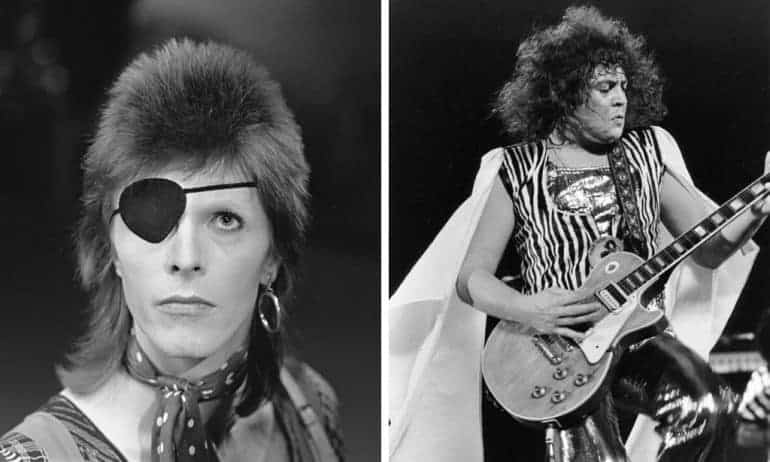It is often said that Marc Bolan and David Bowie were the godfathers of glam rock, but how did the pair earn this title…
It was an unassuming March evening in 1971, and Top of the Pops had invited glam rock band T. Rex to perform their new single “Hot Love.” The band’s lead singer, Marc Bolan, appeared a corkscrew-haired mix between elf and electricity.
Small of stature and dressed in satin, Bolan strummed his Les Paul guitar as studio lights cast shadows upon two silver dabs of glitter adorning his cheeks.
The End of the Swinging Sixties
This generally accepted glam rock genesis perhaps signified the definitive ending of the 1960s. Characterized by immense social, cultural and political upheaval, it was no surprise that the decade of revolution had resisted an unceremonious burial.
Instead, the sixties were cremated and blown up into the night sky. Creating a scintillating handful of stars for a brand-new generation.
From an otherwise dull musical landscape emerged glam rock’s two glittery godfathers: Marc Bolan and David Bowie. Born within nine months of each other, Bolan (born Mark Feld) and Bowie (born David Jones) had already lived somewhat parallel lives by the time they first met as fresh-faced mods in 1964.
Embed from Getty ImagesBoth young men came from London and were eager to embark on a musical career, having displayed artistic sensibilities from a young age. Perhaps unsurprisingly, after settling on stage names and shuffling through managers, an intriguing friendship would develop between the two of them. With empty pockets and sky-high ambitions, the pair would scour dustbins on Carnaby Street in search of the perfect ensemble.
The Summer of Love
1967 saw the Summer of Love culminate across the Atlantic Ocean. By fall, both Bowie and Bolan had released several unsuccessful folk recordings reminiscent of artists like Bob Dylan and Donovan. David’s 1967 self-titled debut album, David Bowie, would be his last for two years.
Meanwhile, following a brief stint as the lead guitarist of the psychedelic rock band John’s Children, Marc would emerge as one half of the psych-folk duo Tyrannosaurus Rex with percussionist Steve Peregrin Took.
The pair would achieve moderate success together, releasing three whimsical albums before the sixties drew its final breath: My People Were Fair and Had Sky in Their Hair… But Now They’re Content to Wear Stars on Their Brows (1968), Prophets, Seers & Sages: The Angels of the Ages (1968) and Unicorn (1969).
In early 1969, Bolan invited Bowie, who had been training as a mime under the mentorship of Lindsay Kemp, to open for Tyrannosaurus Rex on tour. Much to Marc’s amusement, the performance was poorly received, sparking a sense of artistic rivalry.
Though Bolan appeared to have secured the creative upper hand, the tables would soon abruptly turn. Following the tour, Took would leave Tyrannosaurus Rex over alleged creative differences.
Embed from Getty ImagesAt the same time, Bowie would score a top-five hit with “Space Oddity”. Though envious, Bolan would remain interested in his friend’s work and even occasionally contribute to David’s music. In return, Bowie would make numerous references to Marc, most notably by name-checking T. Rex in glam’s angsty teen anthem “All the Young Dudes”.
The Birth of Glam Rock
In January 1970, Marc was invited to play guitar on Bowie’s “The Prettiest Star”. Intended as the follow-up single to “Space Oddity”, David had written the song about his girlfriend Angela Barnett. The couple would wed in March, a mere few weeks after Bolan’s marriage to former secretary June Child. The session was arranged by their producer Tony Visconti, who would soon join Bowie’s backing band Hype.
According to Visconti, the session went well. That is, until June Child dissed the track, stating that her boyfriend was too good to be playing on it. However, if Bolan agreed that David’s latest composition wasn’t up to scratch, it didn’t stop him from attending what Visconti considers to have been the “very first night of glam rock”.
An unspectacular turn of the decade had made Bowie acutely aware of the dull and uninspired music industry he had recently broken into. Dominated by the seemingly infinite ballads of progressive rockers and the increasingly outdated folk tunings of fledgling singer-songwriters. Following a conversation about “supermen and superstars” with photographer Ray Stevenson, David decided to play space-age dress-up.
Embed from Getty ImagesIntroducing Hype
On February 22nd, 1970, Bowie and his newly-formed Hype, consisting of Visconti on bass, Mick Ronson on guitar and John Cambridge on drums, made their live debut at London’s Roundhouse wearing makeup, satin capes, silver belts, colorful leotards, and leather boots.
For an audience largely evocative of the denim-clad, hippie crowd at Woodstock, Hype’s futuristic attire was not necessarily well-received. However, unbeknownst to the band, there was at least one receptive guest within the audience.
Though he would later deny ever attending, a photo unearthed towards the end of the seventies shows a wide-eyed Bolan gazing up at Hype’s proto-glitter attire. Nonetheless, an indifferent audience had disappointed David, who would soon ditch the outfits.
It would take two years for Bowie to embrace another flamboyant facade in the form of Ziggy Stardust. By which time Marc would already be wearing feather boas and women’s shoes. In the meantime, David would grow out his hair and raid his wife’s wardrobe. As demonstrated on the covers of The Man Who Sold The World (1970) and Hunky Dory (1971).
To what extent Bolan had been inspired by Hype’s Roundhouse performance is difficult to determine. What is certain is that Marc had already begun experimenting with an electric sound reminiscent of the great rock ‘n’ rollers of his youth. Including the likes of Elvis, Buddy Holly, and Little Richard.
Embed from Getty ImagesA Beard of Stars, released less than a month after Hype’s Roundhouse debut and featuring new percussionist Mickey Finn, is a largely transitional album. It was the last to be credited to Tyrannosaurus Rex and the first to use an electric guitar.
Feeling adventurous, Bolan would soon buy himself a vintage Gibson Les Paul. This shortly before recording what is considered to have heralded the glam rock movement: “Ride A White Swan.”
Released in October 1970, “Ride A White Swan” (partially inspired by Mungo Jerry’s “In The Summertime”) was the first single to be credited under the newly-shortened title of T. Rex. Visconti had allegedly grown tired of writing out the band’s full name in the studio and had begun to abbreviate it.
Though slow to climb the charts, the guitar-driven ditty would eventually peak at number two in January 1971. Remaining at the top position for six weeks.
Emboldened by the success of the single, Bolan would expand his band into a quartet with the addition of drummer Bill Legend and bassist Steve Currie. The upscaled lineup was quick to record a follow-up single titled “Hot Love.” A suggestive little boogie that would become T. Rex’s first number-one single in March 1971.
To complement his band’s new sound, Bolan would undergo a glamorous image overhaul. Formerly presenting as a bohemian mystic with Tolkien inspired lyrics, Marc now donned colorful top hats, feather boas, and embroidered jackets. No longer sitting cross-legged on the floor, his petite frame radiated an exuberant air.
The striking transition was aided by the fashion-conscious eye of Marc’s personal assistant Chelita Secunda. She is thought to have applied glitter to Bolan before his appearance on Top of the Pops. Though Marc would later claim to have done it himself.
Nonetheless, T. Rex’s performance of “Hot Love” would introduce an entire generation to the extravagance of glam rock. A genre built upon the foundations of rockabilly enwrapped in the glitzy get-up.
Bowie’s Reinvention
After a brief absence from the charts, David Bowie would break into glam with his critically-acclaimed The Rise And Fall Of Ziggy Stardust And The Spiders From Mars, released in June 1972. Bowie had first conceived his androgynous alter-ego over a year earlier and had been testing the waters performing as Ziggy since February.
Embed from Getty ImagesWith a new backing band consisting of Mick Ronson on guitar, Trevor Bolder on bass and Mick Woodmansey on drums, Ziggy made his Top of the Pops debut on July 6th, performing his new single “Starman.”
The performance, which featured a red-haired, near translucent-skinned Bowie placing a lithe arm around Ronson’s shoulders, was unlike anything ever seen on British television before. Bolan’s cosmic counterpart had taken glam to a new, theatrical level.
By this time, the release of Electric Warrior in September 1971 had established T. Rex as one of Britain’s most popular acts. The album was a major hit, spawning the singles “Bang a Gong (Get It On)” and “Jeepster.”
Bolan’s good looks and subtle sensuality had garnered the group an incredibly dedicated female fanbase. The mass hysteria that swept across the nation was dubbed “T. Rextasy,” a term coined by Marc’s publicist to conjure rampant images of Beatlemania.
A mere six weeks after Ziggy’s television debut, the band would add to their success with The Slider. The album was another commercial success, producing the number-one singles “Metal Guru” and “Telegram Sam.”
Between 1970-73, T. Rex would produce 11 top ten hits. These interspersed between the singles of other rising glam acts like Sweet, Slade, Gary Glitter and Roxy Music.
In April 1973, David Bowie would strike again with Aladdin Sane, described by Bowie as “Ziggy goes to America.”
Embed from Getty ImagesUnlike Bolan, David had succeeded in breaking the American market and had been touring there under his Ziggy Stardust guise. The album would produce two hit singles: “The Jean Genie” and “Drive-In Saturday.”
At the same time, Bowie would see success with the non-album single “John I’m Only Dancing” and “All the Young Dudes,” written by David for Mick Ralphs‘ Mott the Hoople. According to Visconti, Bolan was feeling threatened by his friend’s success, though T. Rex’s fame had not yet declined.
Interestingly, the band’s seventh album Tanx, released in January, would touch upon elements of blue-eyed soul that David would later explore in his 1975 album Young Americans.
The End of Ziggy Stardust
In the summer of 1973, Bowie would make the seemingly inconceivable move of retiring the character that had catapulted him to fame. Ziggy Stardust made his final appearance at London’s Hammersmith Odeon on July 3rd, to an especially frenzied crowd.
The memorable performance occurred at a time when five of Bowie’s albums were in the charts, as well as the Hunky Dory single “Life On Mars,” released in June.
Embed from Getty ImagesDuring the performance, Bowie had ambiguously stated that the show would be his last, leading many fans to believe he was retiring rather than killing off his widely-lauded persona. However, by the release of the sixties cover album Pin Ups in October, David’s true intentions had transpired. The soon-to-be heralded visionary was simply ready to move on from glam rock music.
In early 1974, Bowie would move to the United States. Released in May, Diamond Dogs would prove his last contribution to glam rock. With the hit single “Rebel Rebel” serving as the dying genre’s final anthem. However, according to his fellow glam kingpin, the glitter movement had already burned out over a year earlier.
David Bowie – Rebel Rebel (1974)
In June 1973, several weeks before Ziggy’s retirement, Bolan had made the somewhat premature declaration to Melody Maker that glam rock was “dead.” This statement was likely the result of Marc’s own musical insecurities: Tanx had reached No. 4 in the UK albums chart but produced no notable singles.
The album’s release would mark T. Rex’s progressive decline. Released in March 1973, the non-album single 20th Century Boy would be the band’s last major hit.
Released in February 1974, Zinc Alloy and the Hidden Riders of Tomorrow was criticized by the music press for copying Bowie’s Ziggy Stardust album. Despite the fact that Marc had spoken of using a “Zinc Alloy” pseudonym since the sixties.
Following its release, an increasingly insecure and egotistical Bolan would break from Visconti, tainting the production value of T. Rex’s future albums.
To avoid paying tax, Marc would join David in the United States, where both men would pick up a penchant for white powder. Fortunately for Bowie, cocaine proved an immense aid to his creativity and drive. Over the next few years, David would establish his longevity beyond glam with a string of critically acclaimed albums: Young Americans (1975), Station to Station (1976), Low (1977) and Heroes (1977).
Meanwhile, substance abuse would put a strain on Marc’s musical abilities. Unable to reinvent himself, Light of Love (1974), Bolan’s Zip Gun (1975) and Futuristic Dragon (1976) all failed to make a notable impression on Bolan’s one-time audience. Many of whom had since grown up and turned their heads to disco and punk.
Unlike many of his contemporaries, Marc would embrace the latter genre during a brief comeback towards the end of his career, touring with The Damned. Released in March 1977, Dandy in the Underworld proved T. Rex’s highest-charting album in three years.
Having regained his pre-cocaine vitality, Bolan would host his own pop music show called Marc. The series produced a mere six episodes. Coming to an abrupt end after Bolan was killed in a car crash in September 1977.
The End of an Era
Aired after his funeral, what proved to be the last episode of Marc was filmed only a week before Bolan’s death. The episode featured a performance from Bowie, who had paid a visit to his old friend whilst in the midst of promoting Heroes.
Towards the end of the show, Marc joined David on stage for a jam of an untitled song that the two had written together. Viewers watched as Bolan tripped on a microphone wire and fell off the stage, leaving Bowie to laugh as the credits rolled.
Decades later, this sight remains eerily symbolic. After launching the high-speed ship of glam rock, Bolan proved unable to shake off the glitter. Marc carried the genre to the grave, sinking into the ocean as Bowie watched on from the shore.
Though they ended up on different musical paths, Marc Bolan and David Bowie are forever immortalized as the godfathers of glam rock who electrified an otherwise static world.
Article written by Paris Turner
Similar Articles…
- June Child – The Complete Story of Marc Bolan’s Muse & Wife
- Nancy Spungen & the Day Punk Died
- A Modern Member of The Glam Rock Crowd – Lenny Kravitz
- The Alice Cooper Fact Sheet – 5 Things You Need To Know - January 12, 2023
- Everybody Knows The Words, But What Is Hotel California About? - April 29, 2022
- What Is The Meaning Of Stairway To Heaven: Led Zeppelin’s Amazing 1971 Musical Epic? - April 24, 2022


